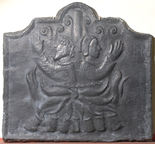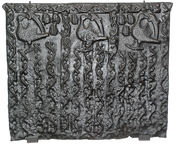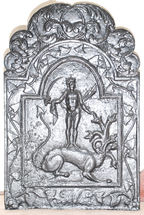-
396
Description: Cavetto-canted rectangle with arched top; astragal and cavetto edging (top and sides); pictorial; back-to-back figures of a bearded man and a woman in a poke bonnet, both dressed in tunics, their arms raised, respectively left and right; they are chained to a vertical pole; below, flames issue from vertically stacked logs, while smoke rises above them; the physical proportions of the figures are naïve, the man’s eyes being over-large, as are the hands of both.
Notes: The design is a free adaptation of an illustration from The Book of Martyrs by John Foxe (1563), a copy from a back originally noted at Brick Cottage, Burwash, Sussex, in 1871. This may be the design of fireback referred to in an enquiry printed in the St James's Chronicle, or British Evening Post, of 9 August 1788, which described it as 'having two Bishops burning at Stakes thereon' at a house in Warwickshire. At an auction sale in 2017 the same design of fireback was interpreted as the burning of Bishops Latimer and Ridley in 1555. Protestants were burnt to death at several Wealden locations as well as elsewhere in the south-east of England during the reign of Mary I, notably at Canterbury and Lewes. The subject of the fireback should be regarded as symbolic rather than commemorating any individual martyrs.
Copies of this fireback are known.
- Decoration tags:
- rectangular with canted top corners and round arch (shape)
- astragal with cavetto (edging)
- whole carved pattern
- pictorial
- historical
- humans
Manufactured: in the late-16th to early-17th century in the Weald area of England.
Current location: Anne of Cleves House, Southover High Street, Lewes, East Sussex, England.
Museum number: LH000.903 (part of the Sussex Archaeological Society museum group)
Citation: Butterfield, W. R., 1916, 'Old Wealden Firebacks', The Connoisseur, 46, pp. 197-209.
Citation: Dawson, C., 1903, 'Sussex Iron Work and Pottery', Sussex Archaeological Collections, 46, pp. 1-54.
Citation: Paine, C., Aug 2013, 'Mystery of the Two Martyrs', Sussex Past and Present, 130, pp. 6-7.
Citation: Straker, E., 1931, Wealden Iron (London, Bell).
- Attached to series:
- Commemorative firebacks
-
735
Description: Rectangular; three birds (probably swans, a Lancastrian badge) turned to the left, their heads facing right, and the front edge of their left wing extended and inverted; vine pattern strips, one horizontal along the top, and 14, of varied length, vertically across the rest of the fireback; seven ‘grape bunch’ shapes with criss-cross markings, arranged in three groups — 3-1-3 — adjacent to the birds.
Notes: The same vine strips are found on several firebacks, including some of the ‘Anne Forster’ series; the birds are also seen on a number of firebacks; the ‘grape bunch’ shapes may be the same as those on the ‘Anne Forster’ graveslab in Crowhurst church, Surrey. John Starkie Gardner and later writers attributed the birds to an association with the Fowle family; this is unlikely to be correct as the Fowles came to prominence in the iron industry towards the end of the sixteenth century and had their own distinctive decorative emblems. Formerly in the collection of Lady Dorothy Nevill.
- Decoration tags:
- rectangular (shape)
- complex, furniture-derived (edging)
- simple stamps
- carved stamps
- animals
- objects
Manufactured: in the mid- to late-16th century possibly at Pounsley Furnace, Framfield in the Weald area of England.
Current location: Victoria & Albert Museum, Cromwell Road, Kensington & Chelsea, Greater London, England.
Museum number: M.120-1914 (part of the Victoria & Albert Museum museum group)
Citation: Dawson, C., 1903, 'Sussex Iron Work and Pottery', Sussex Archaeological Collections, 46, pp. 1-54.
Citation: Gardner, J. S., 1898, 'Iron Casting in the Weald', Archaeologia, 56, 1, pp. 133-164.
Citation: Straker, E., 1931, Wealden Iron (London, Bell).
- Attached to series:
- Pounsley series
- Vine strip series
- Swan series
- Furniture stamp firebacks
-
803
Description: Arched rectangular central panel, astragal and fillet edge, pictorial, Hercules, sword in hand, preparing to slay the Hydra; Arched rectangular border, fillet edge, ivy leaves and tendrils, monogram at bottom; swirled foliage on top.
Notes: The wooden pattern for this fireback (no. 927), formerly in the custody of William Hobday (d. 1883), last surviving ironworker at Ashburnham furnace, was given to the Sussex Archaeological Society by the Revd. J. Bickersteth. The fireback was previously at a house at Hooe, East Sussex.
Copies of this fireback are known.
Inscription: TAN
- Decoration tags:
- 'Dutch' (shape)
- fillet (edging)
- whole carved pattern
- pictorial
- mythological
- monogram
- text
- humans
Manufactured: in the 18th century at Ashburnham Furnace in the Weald area of England.
Current location: in private hands, Crawley, West Sussex, England.
Citation: Butterfield, W. R., 1916, 'Old Wealden Firebacks', The Connoisseur, 46, pp. 197-209.
Citation: Lloyd, N., 1925, 'Domestic Ironwork I', Architectural Review, 58, pp. 58-67.
Citation: Straker, E., 1931, Wealden Iron (London, Bell).
- Attached to series:
- TAN series
- British 'Dutch' style firebacks


